Street lights go out in Dublin as curfew brought in
Dublin, 25 February 1920 - The introduction of a ‘curfew’ order in recent days has given rise to growing resentment across Dublin City.
The order, which was dated 20 February and came into effect on the 23rd, impacts upon an area that covers an expanse of 36 square miles from Chapelizod to Ballybrack and from Glasnevin to Terenure.
It states that every person within this district must remain indoors between the hours of midnight and 5 am unless they have a permit to be out. In order to receive a permit, an application must be sent to Dublin Castle.
The order is being vigorously enforced by military and police who are stopping every person found out on the streets after midnight and subjecting them to severe cross-examination. Persons found out and about in the city are required, when challenged by a police officer or soldier, to ‘immediately halt and obey the orders given to him, and, if they fail to do so, it will be at their own peril.’ For this reason, some of those with permits are disinclined to use them.
Effects of the order
The impact of the order has been widely felt, particularly by
thousands of night workers including journalists and other
newspaper employees, postal sorters, telegraphists, bakers,
confectioners and dairy workers.
William Paul, Chairman of the Markets Committee of Dublin, has raised concerns about the closure of the Cattle Market until 6am and the damage this will inflict on the shipping of animals cross channel. In a letter to the Irish Independent, Mr Paul said that the operation of ‘military law against the normal trade of our cattle markets’ has destroyed the ‘ordinary healthy competition for supplies.’
Another effect of the order is that much of this area falls into complete darkness each night. This is due to the response of Dublin Corporation which has instructed its employees not to seek permits to operate during the hours of curfew. It further specified that municipal work was to cease from 11.30pm and 8am, and the city lights were to be extinguished at 11.20pm.
Travel has also been severely affected. Passengers arriving in Dublin by the night mail trains are no longer able to avail of any transport at the main terminuses. At Broadstone yesterday, some women and children who arrived by the 12.30 am train and had to carry their luggage through the streets seeking lodgings in inky darkness.
Maternity hospitals have highlighted the risks to pregnant women owing to the inability of medical staff to attend to cases. The matron of the Coombe Hospital noted that nurses responding to calls up to midnight had been strongly advised not to return from their patients’ houses until after 5 am. She added that they frequently received up to 10 calls during this time.
The Dublin Trades Council has urged night workers to refuse to apply for permits, and the Transport Workers’ Union has advised its members not to work during the curfew.
Irish Times' defence
The Irish Times has defended the curfew against charges that it
constitutes a form of military law. The order, it has stated, was
imposed ‘with the sole object of making Dublin safe for
Dublin’s democracy’.
It is ‘impedimental only to the midnight murderer, the burglar, and the footpad. Every honest citizen can get a permit for his lawful occasions.’ The Irish Times has accused the city council of ‘political fanaticism’ in its opposition to the curfew and has argued that there was ‘absolutely no reason… why every one of its servants should not have a permit to be abroad at night, or why the business of the cattle market should be upset’.
[Editor's note: This is an article from Century Ireland, a fortnightly online newspaper, written from the perspective of a journalist 100 years ago, based on news reports of the time.]





















